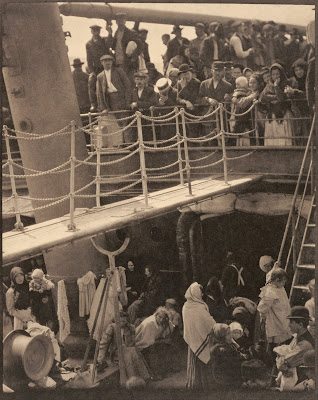'Because things don’t appear to be the known thing; they aren’t what they seemed to be
neither will they become what they might appear to become.'
So wrote Alfred Stieglitz, 24 years after he had taken the photograph – counted as one of the conic moments in both photography and the 20th century. He was not a neutral observer, he was also part of the scene, as he had wandered down from the first-class deck to ‘survey the jumbled scene’ of passengers in the steerage, or economy class, section, which contrasted sharply with ‘the mob called the rich’ that he had left behind.
He also described what appealed to him aesthetically in the scene:
‘The scene fascinated me: A round straw hat; the funnel leaning left, the stairway leaning right; the white drawbridge, its railings made of chain; white suspenders crossed on the back of a man below; circular iron machinery; a mast that cut into the sky, completing a triangle. I stood spellbound for a while. I saw shapes related to one another -- a picture of shapes, and underlying it, a new vision that held me...’
One of the most influential photographers of the 20th Century, Stieglitz argued that photography should be taken as seriously as an art form. His work helped to change the way many viewed photography while his galleries in New York featured many of the best photographers of the day.
This image, simply called ‘The Steerage’, not only encapsulates what he called ‘straight’ photography – offering a truthful take on the world – but also tries to give us a more complex understanding by conveying abstraction through shapes and their relationships to one another.


3 comments:
While Stieglitz renews one’s vision, as it were, I have my doubts about his ‘offering a truthful take on the world’. Was it truthful? Was he truthful? On the other hand, what would it mean not to be truthful?
Stieglitz himself, although he wrote, ‘THE SEARCH FOR TRUTH MY OBSESSION,’ described his work like this: ‘I have a vision of life, and I try to find equivalents for it in the form of photographs.’ Which seems rather that his own vision of life was prior to anything else.
A simple truth about this photo. Stieglitz overwhelmingly discerns the inanimate and abstract, which seems to deny what one actually sees. One may also ask what he chose to exclude, not merely in this photo, but all his photos.
It seems to me that he sought a kind of stability, security, reassurance, even immortality, in shapes. Let us remember those things not made with hands, eternal in the heavens ...
To me this picture is a lot about abstractions and directions, mass and shape. Almost as if out of a blur of ink, slowly we can distinguish stories. A trespassing of the industrial revolution, dreams, transformation, which seem to pack together on the deck of a ship. The ship is not that visible and rather felt, caused by the angle out of which this picture was taken. (There is a slight seasickness about it).
Somehow I do perceive the entrance for the fourth dimension in this picture, and at the time it was taken, hence, this is something.
Stieglitz said, ‘I saw shapes related to one another — a picture of shapes’. Well, truth be told, I don’t. For me, the shapes are a lesser indulgence. An indulgence for those who can afford it. Instead, in ‘The Steerage’, I see caste. I see separation. I see inequality. I see degradation. I see have-nots. I see unintended shame — not of the people packed into steerage as if, in Stieglitz’s words, ‘packed like cattle’, but of the system sinisterly lurking behind the scene. Sure, these immigrants were likely uplifted, clinging to hope that America would be the start of a wholly new, improved life for their families. Especially for their children and grandchildren. That is, to turn hopelessness into hope, however raw that new start might prove. Yet, at the same time, the word ‘steerage’, with all of its eventual dark social and historical connotations speaks a lot — for me, more than shapes formed by the leaning funnel, man’s suspenders, chain link, and so forth. That is, the term speaks far more consequentially than ‘the study in mathematical lines, in balance, in a pattern of light and shade’ that Stieglitz later rather distantly described this scene of miserable, inhumane conditions.
Post a Comment